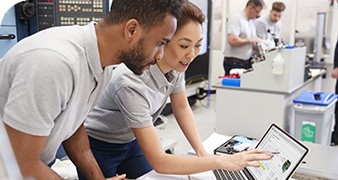Automotive HIL Course Overview
The Automotive HIL course will teach you to build, configure, and maintain HIL systems for component (subsystem) level HIL, and how to transition from this setup into system-level HIL. The course covers the major components of the HIL workflow, including system set-up, model and Custom Device integration, vehicle bus protocol fault insertion, residual bus simulation, use of Automotive toolkits, automated testing, debugging, and system management.
Available in the following formats:
Virtual training not available for this course
Classroom training not available for this course
Private training not available for this course
Course Objectives:
-
Explore component-level and system level HIL
-
Specify your HIL System
-
Configure your HIL System in VeriStand
-
Integrate models and custom devices into VeriStand projects
-
Utilize vehicle bus protocols and restbus simulation
-
Perform hardware and software fault insertion
-
Use Measurement & Calibration and Diagnostic automotive toolkits
-
Debug and troubleshoot your HIL system communications
-
Perform automated testing in VeriStand or Python
-
Manage your HIL system using SystemLink
Course Details
Duration
-
On-Demand: 4.5 hours
Audience
-
HIL System users or test engineers responsible for setting up, reconfiguring, operating, or troubleshooting a HIL system.
Prerequisites
-
HIL Fundamentals Using VeriStand
NI Products Used
-
VeriStand
-
TestStand
-
LabVIEW
-
SystemLink
Training Materials
-
On-demand training includes digital course materials delivered through the NI Learning Center, available for the access duration of your subscription
Cost in Credits
-
On-Demand: Included with software subscription and enterprise agreements, or 5 Education Services Credits, or 2 Training Credits
Automotive HIL Course Outline
| Lesson | Overview | Topics |
|---|---|---|
Introduction to HIL Test | Explore what HIL Systems are, how they are used in the industry and what NI can offer for HIL systems. |
|
How to Create a HIL System Based on Requirements | Explore how to put together a HIL system based on given / known requirements |
|
Configuring System Setup in NI VeriStand | Explore how to set up a HIL setup in NI VeriStand, as well as how to use the System Explorer and other NI VeriStand features. |
|
Models and Custom Devices in HIL | Explore how to create models and custom devices in HIL and add them into VeriStand. |
|
Communication Protocols in VeriStand | Explore supported vehicle bus protocols in VeriStand, fault insertion of these vehicle bus protocols, and residual bus simulation. |
|
Communicating with Test Objects | Explore NI's automotive toolkits and the functionality they provide, as well as dive into the methods of interacting with and protecting a DUT. |
|
System-Level HIL | Explore how to move from component level/sub-system HIL to system-level HIL. |
|
Performing Autonomous Real Time Testing | Explore the available options for automating real-time sequences in the VeriStand and Python environments. |
|
Test Executives and Data Analysis | Explore the available options for automated testing using an NI HIL platform and how to automatically format and report data outputted from a test. |
|
Debugging and Troubleshooting | Explore various debugging techniques in NI VeriStand. |
|
System Management Using SystemLink | Explore NI SystemLink and why we use it to manage Automotive HIL systems. |
|
Continue your learning path
SLSC Fundamentals
This course prepares you to extend the configuration of your HIL system by exploring additional configurations such as bus simulation, custom devices and test automation.
HIL Fundamentals Using VeriStand
This course reviews common automotive communication protocols and teaches students basic communication with Restbus using LabVIEW, C, and the custom device in VeriStand.
Software Engineering for Test Applications
Build upon foundation by focusing on LabVIEW tools and industry practices that aid in the definition, management, design, development, validation, and deployment of a quality solution.
Upgrade to Membership
Planning to take three or more NI instructor-led courses within one year?
A Training Membership provides cost-effective, unlimited access to all NI public classroom and public virtual courses, along with unlimited certification vouchers.


